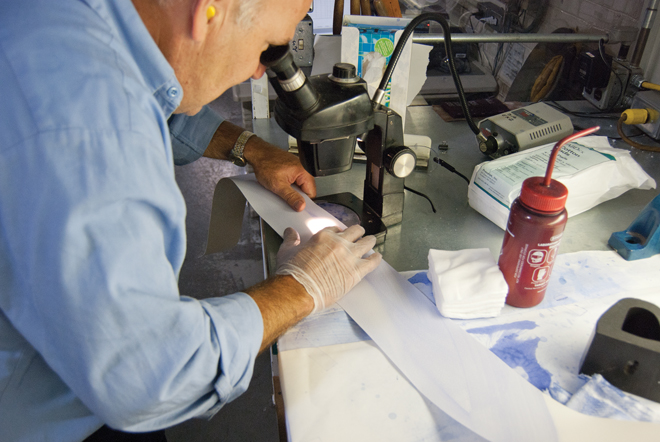The Post-Paper Mills
By Maura Ewing
Photographs by Mark Marchesi
Two innovative companies are taking one of Maine’s former cornerstone industries—pulp and paper—into the twenty-first century. Sappi Fine Paper North America and Old Town Fuel and Fiber are not only leaders in the field, but they just may be the innovative bellwether operations that Maine has been waiting for.
OLD TOWN FUEL + FIBER
Old Town Fuel and Fiber’s towering stacks are visible from the edge of the small central Maine town. Billowing steam paints the sky with white strokes that announce the pulp mill’s importance. But the casual passerby may be surprised to find out that the traditional-looking mill is on the cutting edge of green biofuel technology.
Inside the factory a mechanical cacophony blares. Dan Bird, one of the mill’s managers, shouts rapid-fire explanations of the mill’s inner workings with the familiarity and pride one would expect on a tour of his personal home. He has, in fact, spent more time in this building than most people spend in their homes. “I would come in here when I was eight or nine years old to visit my grandpa. I used to run all around here,” he says. His look indicates that running through the industrial maze wouldn’t be such a great idea anymore. “That was before we had tight safety regulations,” he finishes. At 53, Bird has had a career here that spans three decades. His wife also worked in the mill for 21 years, and he now knows all 200 employees by name, not to mention the names of their spouses and children.
Bird currently directs the human resources, information technology, and health and safety departments. “It still amazes me to think of the number of people they used to have doing my job. And not just me—that’s the story for a lot of us,” he says. Although the mill employs roughly one-fifth the number of workers that it did when Bird started, it would have no employees if not for the company’s new biofuel project.
We pause beside what looks like a giant cauldron. The dark, steaming liquid inside is a byproduct of the pulping process—and the key to the company’s renewed vitality. Typically, the byproduct is condensed and burned in a mill’s boiler as an internal source of energy. But in 2007 laboratory researchers at the nearby University of Maine successfully developed a process that can convert the liquid into biobutanol, a renewable gasoline alternative. Old Town Fuel and Fiber plans to begin commercial biofuel production by 2013. They have joined companies across the globe in a race to find the next generation of biofuel.
In the office building across from the truck-filled parking lot, Dick Arnold, the company’s president, sits behind his meticulously organized desk. He strokes his gray mustache with authority. “We’re a small pulp mill. We can’t compete with plants that are ten times our size, and that’s the global market,” he says. “Without biofuels this place would not be operating.”
The mill’s history illustrates the importance of diversification. In 2006 its longtime corporate owner, Georgia-Pacific, shut the facility down. The next owners, Red Shield, spearheaded the biofuel operation. The company was still vulnerable to the fluctuations of the pulp market, however, and funding dried up before the biorefinery became operational.
A few months later, Patriarch Partners, a New York–based private-equity firm, unexpectedly swept in to buy the distressed facility and immediately invested $40 million into the biorefinery project. The head of Patriarch Partners, Wall Street veteran Lynn Tilton, believed in the project’s viability and recognized the benefits of a steady source of aviation fuel for her helicopter business.
In the market for renewable fuel, Old Town Fuel and Fiber’s model already surpasses a hurdle faced by other producers: sustainability. “We have the long-term practices built in and the infrastructure to handle it—not only here at the mill but also in the woods, which is really key,” Arnold says. The parallel biofuel production does not require more wood, but it will add a tremendous amount of value to the facility. Currently, the most used renewable fuel in the United States is corn-based ethanol. The use of cornfields to “grow” fuel has sparked some controversy, with debates centering on issues such as land use, subsidy allocation, soil health, and rising food prices.
Arnold travels to biofuel-related conferences across the country where researchers are often surprised to learn that such innovative technology is coming out of Maine. “Our state has a lot of technical competencies that people don’t recognize because we’re Maine. That’s a reputation that our state has to get over,” he says. “When you look at the Department of Energy’s map for all of the biofuel projects, you see Old Town up there. We’re one of the only ones,” he says, gesturing to his sparse office. “Yeah, here we are.”
While developing the biorefinery, the company is also working out glitches and improving technology. “We’re hoping that the model we develop can be easily implemented in other mills,” Arnold says. If they are successful, which he is confident they will be, “the second plant and the third plants will be much better.” And, of course, their start-up costs will be significantly lower. The added revenue from fuel could save distressed mills, enabling them to keep ahead of global competition. Maine may well become the next viable source for renewable fuel.
SAPPI FINE PAPER, NORTH AMERICA
Maine’s oldest working paper mill, originally built in the 1840s, sits on the outskirts of Westbrook. Men in navy canvas pants filter in and out of the red-brick fortress, their chatter muffled by an industrial whirr emanating from the walls behind them.
The scene is nostalgic, but the company’s Warren Release Papers are a far cry from traditional card stock or tissue. Although paper is the base of Warren Release Papers, their value is in the intricately textured coatings that cover them. The mill’s promotional pamphlet displays a pair of soccer cleats and reads “Sappi makes the texture…texture makes the difference.”
To understand the connection between a piece of paper and the intangible idea of “texture creation” requires a little patience and an open mind. In short, the paper serves as a base for a mold, and manufacturers purchase the mold to create synthetic textured finishes for their goods. The wide-ranging list of textured products includes Brazilian high-heeled pumps, Italian synthetic-leather jackets, Chinese sandals, automobile dashboard covers, Nike soccer cleats, and Izod athletic shoes, to name just a few. Work-related conversations at Sappi flow seamlessly from paper-machine maintenance to European fashion trends.
Inside the mill’s Ultracast room, bright fluorescent lights illuminate four silver machines, each about the size of a U-Haul. This is where the magic happens.
Al Blanchard, a supply chain manager, walks to a stack of coated paper. “This is the end product. It’s worth seven times the paper going in,” he explains, pointing to a large roll of white paper across the room.
Two relaxed workers, David Currier and Darryl Dyer, sit at the control station in the center of the room. They wear matching button-up shirts with blue collars, and their hair is a similar shade of gray. “I’ll have 40 years when I retire, my father had 40 years, my grandfather had 40 years, and my great-grandfather had 40 years,” Dyer says. Currier looks to his work partner. “I’ve been here for 34 years. The sad part is that I’ve worked with Darryl for 25 of those years,” he jokes.
Dyer ignores the playful jab and focuses on the work at hand. “I like our new one: Gobi. It’s one of the nicest looking patterns we’ve made.” Currier takes me to a microscope where we inspect a release paper. The lens reveals an intricate patchwork of squares and circles. I close my eyes and rub the paper—it feels just like woven fabric.
In the brick-walled conference room below, Donna Cassese, a mill manager, sifts through a pile of samples. Her 34 years of working for Sappi do not seem to have quieted her enthusiasm for the company’s products. “We’re here in this old mill, so we go down to New York City a lot to see what’s happening in the fashion world, right?” she asks rhetorically. Her rapid speech and the way she says “New York” give away her Big Apple origins. “So our marketing director is walking down Fifth Avenue and sees this jacket in the window,” Cassese says as she hands me the jacket. “That texture is our Solari pattern. This is a thousand-dollar Gucci jacket. We joked because he bought it in his size,” she says with a laugh.
The slick fabric shimmers in the light, which gives its dull color an eye-catching look. “This texture is very popular right now. Our sales director in Italy says that all the men there are wearing little puffy vests made with this material,” Cassese says.
Going against contemporary trends in American paper manufacturing, Sappi’s market is primarily in Asia. “Isn’t it wonderful? The Chinese are buying from us!” Cassese exclaims.
Squashing expectations is not a new trick for Cassese. Infatuated with science when she was growing up in the Bronx, she felt compelled to enter a field of study far removed from her all-girl Catholic high school and concrete-jungle neighborhood: forestry. Her first assignment at the University of Maine was to identify tree species. “I wrote ‘Christmas tree’ for all ten,” she remembers. The professor gently suggested that she was in the wrong department. “Of course being from the Bronx, I’m like: Well, isn’t this what you’re supposed to teach me?” She laughs in a manner that indicates she has made this joke before.
Soon after her college graduation, she joined the male-dominated ranks of foresters at Sappi. “I think it’s fair to say that I’ve been the first woman in every position I’ve held,” she says. After working in the woods for 15 years, her boss pulled her inside to join the corporation’s managerial ranks.
After a truly confusing mill tour, I exit the building holding a gift from Cassese: a lime-green notebook with a cover that is textured with Sappi’s Bling pattern. A man holds the door open for me, tilts his hard hat, and looks down to admire the notebook. “You know,” he says, “we used to make the pages.”
Perhaps the most important distinction between Sappi and many other companies in the field can be found in the local classified ads: Sappi is hiring.














